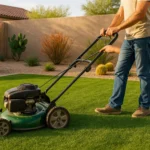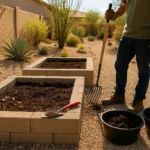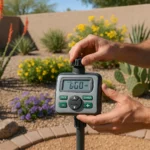As Mesa’s temperatures begin to climb and days grow longer, your warm-season grass is preparing for its annual comeback. But before your Bermuda or other warm-season turf can truly thrive, it needs some thoughtful attention during this critical transition period. That’s where soft pruning comes in – a gentle yet effective technique that helps your lawn transition successfully between dormancy and active growth. Unlike aggressive scalping that can stress your grass, soft pruning provides just the right amount of maintenance to encourage healthy development while preserving your lawn’s resilience.
What Is Soft Pruning and Why It Matters for Mesa Lawns
Soft pruning is a moderate approach to lawn maintenance that involves trimming your warm-season grass to a manageable height without cutting it extremely short. Unlike the more aggressive scalping method, soft pruning removes just enough of the dormant, brown top layer to allow sunlight to reach the crown of the grass while maintaining sufficient leaf surface for photosynthesis. For Mesa homeowners, this balanced approach is particularly valuable as our intense desert sun can quickly stress freshly cut grass that’s been trimmed too severely.
The technique matters significantly for our local climate because Mesa experiences rapid temperature changes during transition seasons. When you soft prune rather than scalp, you’re providing your lawn with a buffer against unexpected temperature drops that sometimes occur in early spring. The moderate height retention helps protect the crown of the grass – the growth center where new shoots emerge – from both cold snaps and excessive heat, giving your lawn the best chance to transition smoothly into its active growing season.
Additionally, soft pruning helps manage thatch buildup without removing too much protective material at once. Thatch is the layer of dead and living stems, roots, and crowns that accumulates between the soil surface and green vegetation. While some thatch is beneficial, excessive amounts can block water, nutrients, and air from reaching the soil. The balanced approach of soft pruning helps maintain just the right amount of this protective layer for Mesa’s challenging climate conditions.
Timing Your Soft Pruning for Optimal Results
In Mesa, timing is everything when it comes to soft pruning your warm-season grass. The ideal window typically falls between late February and early April, depending on the specific weather patterns of the year. The key indicator isn’t just the calendar date but consistent soil temperatures. You’ll want to monitor when soil temperatures consistently reach 65°F at a depth of about 2-4 inches. This temperature range signals that your Bermuda grass or other warm-season varieties are ready to emerge from dormancy and begin active growth.
Pruning too early can leave your lawn vulnerable to late cold snaps that occasionally surprise Mesa residents, potentially damaging the emerging growth. On the other hand, waiting too long means your grass will have already invested energy in growing through the dormant thatch layer, making the pruning process more stressful on the plant. For most Mesa neighborhoods, mid-March typically hits the sweet spot, but it’s worth checking soil temperatures or consulting with local lawn care experts if you’re uncertain.
Weather forecasts should also factor into your timing decision. Ideally, you want to soft prune when there’s a stretch of mild weather ahead – not immediately before an extreme heat event or cold front. This gives your grass time to recover from the pruning stress under favorable conditions. Also consider rainfall patterns; soft pruning just before a gentle rain can be beneficial, as the moisture helps the grass recover more quickly without the need for additional irrigation, which is always a consideration in our water-conscious desert community.
The Step-by-Step Soft Pruning Process
Begin your soft pruning project by adjusting your mower to the right height setting. For Bermuda grass, which is common in Mesa lawns, set your mower about half an inch to one inch lower than your normal mowing height during the growing season, but never lower than 1 inch total. This provides the perfect balance of removing enough dormant material while preserving adequate leaf surface. Before starting, ensure your mower blades are sharp to make clean cuts that heal quickly and reduce stress on the grass.
When you’re ready to mow, make sure the lawn is dry to prevent clumping and uneven cutting. Work in a systematic pattern across your yard, slightly overlapping each pass to ensure even coverage. Unlike scalping, you’ll likely only need to make a single pass with the mower, as the goal isn’t to remove all brown material but rather to thin it out strategically. After mowing, rake the lawn lightly to remove loose clippings and provide additional gentle thatch management without being overly aggressive.
Following the pruning, proper aftercare is essential. Water the lawn thoroughly but not excessively – about half an inch of water is typically sufficient to help the grass recover without promoting fungal issues that can develop in overly wet conditions. Hold off on applying fertilizer immediately after soft pruning; wait about two weeks or until you see consistent new green growth emerging. This prevents pushing growth before the grass has recovered from the pruning stress and allows you to fertilize when the grass can most effectively utilize the nutrients.
Soft Pruning vs. Scalping: What’s Best for Mesa’s Climate

The debate between soft pruning and scalping isn’t just academic – it has real implications for lawn health in Mesa’s unique desert environment. Scalping involves cutting the grass extremely short (often down to half an inch or less) and removing nearly all the dormant material. While this practice has traditionally been recommended for warm-season grasses, it comes with significant risks in our intense desert climate. The extreme cutting height exposes the crown of the grass to potential sunburn and desiccation, especially during unexpected hot spells that can occur during our transition seasons.
Soft pruning offers several distinct advantages for Mesa lawns. First, it reduces water requirements during the critical transition period. When you maintain more leaf surface through soft pruning, the grass retains more moisture and requires less supplemental irrigation to recover – an important consideration in our water-conscious region. Second, the moderate approach helps prevent weed invasion. Scalped lawns essentially create a blank canvas for weed seeds to germinate with full sun exposure and little competition, while soft-pruned lawns maintain enough density to naturally suppress many weeds.
The temperature fluctuations common in Mesa’s spring season also favor soft pruning. Our region can experience 30+ degree temperature swings within a 24-hour period during transition seasons. A soft-pruned lawn has more insulating material to buffer these changes, protecting the crown of the grass from stress. While scalping might be appropriate in more humid regions with stable spring temperatures, Mesa’s climate conditions generally make soft pruning the more reliable approach for most homeowners seeking to balance lawn aesthetics with practical maintenance concerns.
Equipment and Tools for Effective Soft Pruning
Successful soft pruning starts with having the right equipment. A rotary mower with sharp, balanced blades is ideal for most Mesa homeowners. The key is ensuring your mower can be adjusted to precise heights and has sufficient power to cut through partially dormant grass without bogging down. If your mower struggles with height adjustments or lacks power, consider renting a professional-grade mower for this specific task – the investment will pay off in more even results and less stress on your lawn.
Beyond the mower itself, several supporting tools enhance the soft pruning process. A flexible leaf rake helps remove loose material without pulling up living grass crowns. A soil thermometer is invaluable for timing your pruning correctly by monitoring soil temperatures at a 2-4 inch depth. For larger properties, a lawn sweeper can efficiently collect clippings after pruning, preventing them from smothering new growth. And don’t overlook personal protective equipment – gloves, eye protection, and a dust mask are important, especially for allergy sufferers, as dormant grass can release significant amounts of dust and pollen during pruning.
Maintenance of your equipment is equally important as having the right tools. Before soft pruning, take time to sharpen mower blades, check and adjust belts, and ensure the mower deck is clean and free of built-up grass residue that could affect cutting performance. Clean tools not only perform better but also reduce the risk of spreading lawn diseases. After completing your soft pruning, thoroughly clean all equipment before storage to prevent corrosion and extend the life of your lawn care investments.
Special Considerations for Different Grass Types
While Bermuda grass dominates many Mesa landscapes, other warm-season varieties like St. Augustine, zoysia, and buffalo grass also appear in local yards, each requiring slightly different soft pruning approaches. Bermuda grass is the most tolerant of lower cutting heights, allowing for soft pruning down to about 1 inch. St. Augustine, with its broader leaf blades and stoloniferous growth habit, should be pruned more conservatively – no lower than 2 inches – to avoid damaging its above-ground runners. Zoysia falls somewhere in between, typically handling soft pruning to about 1.5 inches without undue stress.
The age and establishment of your lawn also influences your soft pruning strategy. Newly established lawns (less than two years old) benefit from a more conservative approach, as their root systems and growth patterns are still developing. For these younger lawns, consider raising your soft pruning height by half an inch compared to established turf of the same variety. Conversely, well-established lawns with significant thatch buildup might benefit from slightly more aggressive soft pruning to help manage excessive thatch without resorting to mechanical dethatching.
Areas of your lawn that receive different sun exposure should also be pruned differently. South and west-facing sections that receive intense afternoon sun in Mesa’s climate often benefit from slightly higher pruning heights to retain more moisture and provide additional crown protection. Shaded areas typically have thinner grass with less thatch accumulation and may require little to no pruning during transition periods. This zone-specific approach requires more attention but results in healthier grass throughout your property by addressing the unique microclimate conditions that exist even within a single Mesa yard.
Post-Pruning Care to Accelerate Recovery
After completing soft pruning, your Mesa lawn needs specific care to bounce back quickly and transition into vigorous spring growth. Irrigation management becomes critical during this recovery period. The goal is to maintain consistent soil moisture without overwatering. For the first week post-pruning, light, frequent irrigation (about 1/4 inch every other day) helps reduce stress while new growth emerges. Once you see consistent green shoots, transition to deeper, less frequent watering to encourage deeper root development – typically about 1/2 inch every three to four days, adjusted for weather conditions and soil type.
Fertilization timing and selection significantly impact recovery speed. Wait until you see approximately 50% green-up before applying fertilizer, which typically occurs 2-3 weeks after soft pruning in Mesa’s climate. Choose a balanced fertilizer with a nitrogen-phosphorus-potassium ratio around 3-1-2 for best results. Slow-release nitrogen sources are preferable as they provide steady nutrition without forcing excessive top growth before roots can recover. For organic options, consider compost tea applications which provide beneficial microbes along with gentle nutrition to support recovery without chemical inputs.
Traffic management also plays an important role in lawn recovery. Minimize foot traffic and lawn activities for at least two weeks after soft pruning to give emerging grass blades time to develop without physical stress. If you have pets, try to rotate their outdoor play areas to different parts of the yard to prevent concentrated wear patterns during this sensitive recovery period. These simple precautions significantly reduce recovery time and help ensure your Mesa lawn transitions successfully from its dormant winter state to lush spring growth with minimal setbacks.
Troubleshooting Common Soft Pruning Challenges
Even with careful planning, Mesa homeowners sometimes encounter challenges during the soft pruning process. Uneven cutting is among the most common issues, often resulting from mower deck imbalance or varying soil contours. If you notice this problem, make an additional pass perpendicular to your original mowing direction to even out the results. For persistent unevenness, consider using a leveling rake to address minor soil irregularities before your next pruning season, as even small variations in terrain can lead to scalped patches when pruning at lower heights.
Delayed green-up after soft pruning can be concerning, but often just requires patience. If your neighbor’s lawn is greening up while yours remains predominantly dormant two to three weeks after pruning, check soil moisture levels first – dry soil significantly delays transition. A simple screwdriver test (how easily it penetrates the soil) can indicate if additional irrigation is needed. If moisture seems adequate, a light application of iron supplement rather than nitrogen fertilizer can help stimulate chlorophyll production without forcing excessive growth. Soil temperature variations of just a few degrees between properties can also explain different green-up rates, especially in early spring.
Weed breakthrough sometimes occurs after soft pruning as sunlight reaches the soil surface. Rather than immediately resorting to herbicides, which can stress recovering grass, consider manual removal of isolated weeds. For more extensive weed issues, wait until your lawn has achieved at least 75% green-up before applying selective herbicides appropriate for your specific grass type. Pre-emergent herbicides applied about two weeks after soft pruning can help prevent warm-season annual weeds without interfering with your grass’s recovery, providing a proactive solution that minimizes competition during the critical transition period.
Integrating Soft Pruning into Your Annual Mesa Lawn Care Calendar
Successful lawn management in Mesa requires thinking beyond individual maintenance tasks to create a cohesive annual care schedule. Soft pruning should be viewed as one component of a comprehensive approach that prepares your warm-season grass for peak performance during our hot summer months. Following soft pruning in late winter/early spring, plan for regular mowing at appropriate seasonal heights – typically 1.5 to 2 inches for Bermuda during active growth periods, adjusted upward slightly during the most intense summer heat to provide additional stress protection.
Complementary practices that enhance the benefits of soft pruning include core aeration scheduled for late spring (April-May in Mesa), which relieves soil compaction and improves water penetration after your grass has fully recovered from pruning. Summer fertilization should be timed to support growth without creating excess stress, typically with applications in May and September using lower nitrogen formulations during peak heat. Fall transition care becomes important as temperatures cool, with gradually increased mowing heights to provide insulation during winter dormancy, bringing your lawn care full circle to the next soft pruning season.
Record-keeping significantly improves year-over-year results with soft pruning. Maintain notes on pruning dates, heights, recovery time, and any challenges encountered. These records help you refine your approach each season based on what worked best for your specific lawn conditions. Many Mesa homeowners find that digital lawn journals or simple calendar notes about weather conditions, pruning heights, and green-up timing provide valuable insights that allow them to optimize their soft pruning technique. This continuous improvement approach transforms lawn care from a series of reactive tasks to a proactive system that builds healthier turf with each passing season.





